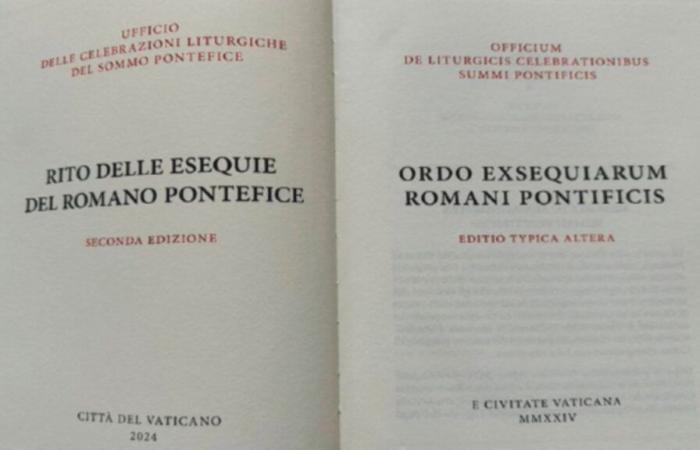The Office of Liturgical Celebrations of the Sovereign Pontiff has edited and published the second typical edition of theOrder of Roman Pontifical Funeralsapproved on April 29, 2024 by Pope Francis, who received the first copy of the volume printed on November 4. Among the new features introduced are the recognition of the death no longer in the deceased’s room, but in the private chapel, the immediate placement in the coffin, the exposure to the veneration of the faithful of the body of the Pope in the open coffin , and the removal of the three traditional coffins of cypress, lead and oak. The liturgical book is presented as a new edition of the previous one, thetypical edition of theOrder of Roman Pontifical Funerals approved in 1998 by Saint John Paul II and published in 2000, which was used for the funeral of the Polish Pope in 2005 and, with adaptations, for those of Pope Emeritus Benedict xvi in 2023. “A second edition proved necessary, explains Mgr Diego Ravelli, master of pontifical liturgical celebrations, above all because Pope Francis asked, as he himself declared to several times, to simplify and adapt certain rites so that the celebration of the funeral of the Bishop of Rome better expresses the faith of the Church in the risen Christ […]. The renewed rite was also intended to emphasize even more that the funeral of the Sovereign Pontiff is that of a pastor and a disciple of Christ and not that of a powerful person in this world.
Continuities and novelties
The office of liturgical celebrations, relying on various experts, therefore carried out an in-depth revision of the entire book, then intervened on the lexicon, the liturgical texts and the individual rites, adapting the entire ritual to the new Constitution Preach the Gospel published in March 2022 which, while maintaining the function of the camerlengo, abolishes the Apostolic Chamber. The three classic “stations” were maintained, the one at the residence of the deceased, the one in the Vatican basilica and the one at the burial site. “However,” continues Mgr Ravelli, “the internal structure of the stations and texts has been reviewed in the light of the experience acquired with the funerals of Saint John Paul II and Benedict XVI, current theological and ecclesial sensibilities and liturgical books. recently renewed. Among the most important new features is the simplification of pontifical titles: the terminology used in the third edition of the Roman Missal (2008) was adopted, namely the designations Papa, Bishop [Romæ] et Pastorwhile in the premises and general headings, the appellation Roman Pontiff was chosen, in accordance with the title of the liturgical book. “The structure of the new Ordoadds the master of pontifical liturgical celebrations, was simplified by revising or eliminating several ritual elements which were difficult to coordinate or which were now considered inappropriate. In addition, the understanding and accuracy of each ritual sequence has been improved, as well as the skills and roles of those involved in the preparation and execution of the rites have been better defined.
The three “stations”
The first station “in the residence of the deceased” includes the novelty of the recognition of the death no longer in the bedroom of the deceased, but in his private chapel, and the placing of the body in a single coffin made of wood and zinc, before be transferred to the basilica. The first translation to the Apostolic Palace was canceled. Certain passages were clarified by remodeling the second station: the placement in the coffin taking place after the death has been confirmed, the coffin is closed the day before the funeral Mass.
The second station “in the Vatican basilica” provides for a single transfer to Saint Peter, the closing of the coffin and the funeral Mass. In the Vatican basilica, the remains of the deceased Pope are displayed directly in the coffin and “no longer on a catafalque”; furthermore, in accordance with what is provided for in Ceremonial of the Bishops for funeral services of diocesan bishops, the pontifical rule is not placed next to the coffin during the exhibition of the remains.
Finally, the third station “at the burial site” includes the trans-lation of the coffin to the tomb and burial. “This station,” explains Mgr Ravelli, “has been the subject of a significant revision due to the removal of the deposit in a cypress coffin nested in a second lead coffin which itself is nested in a third coffin in oak or other wood and closure. Another new element consists of the introduction of the necessary indications for a possible burial in a place other than the Vatican basilica.
In-depth revision of texts
The new edition of theOrder of Roman Pontifical Funerals has been the subject of an in-depth revision concerning the texts of the rubrics, euchology and the Bible. In particular, the Latin prayers had to be conformed to the typical third edition of the Roman Missal of 2008 and the biblical translation of the New Vulgate. “In order to allow greater freedom in the choice of repertoire to be performed,” adds Mgr Ravelli, “it was decided to eliminate musical notation, while inserting precise references to the pages of the Roman Gradual of 1979, as the official liturgical book of song of the Roman Church. Here too, the texts of the psalms have been standardized to the New Vulgate».
Typographical errors have been corrected and the correspondence of some translations with the Latin original has been improved. The litanies of the saints, sung during the funeral rites on two occasions, during the translation of the Pope’s remains into the basilica, in the long form, and during the traditional supplication of the Church of Rome, at the end of the Mass funeral, for which the short form was chosen, has been updated. All the saints celebrated by obligatory feast or memory, indicated in the General Calendar, have been included and supplemented by the insertion of all the Pope saints whose memory is optional appearing in the General Calendar, as well as several saints of the Church of Rome.
The Novemdiales
A fourth and final chapter of the liturgical book is devoted to the provisions relating to the novendiale, the suffrage Masses of the deceased Pope celebrated for nine consecutive days starting from the funeral Mass. Four — and no longer three — prayer forms are included in the ritual, since all those offered by the Roman Missal for the deceased Pope and that for the deceased diocesan bishop have been taken up. Unlike the previous edition, the Lectionary texts are omitted, only biblical indications are offered instead.
Finally, this new edition does not include the substantial appendix with the ordinary of the Mass, the collections of penitential and gradual psalms and the songs of the ordinary with Gregorian notation. “L’Order of Roman Pontifical Funeralsconcludes the master of pontifical liturgical celebrations, is not intended as a “plenary missal”, but rather as a Ordo in the literal sense of the term, which contains the ritual indications, the progress of the rites and the texts, but which otherwise refers to the liturgical books in use, that is to say the missal, the lectionary and the gradual. The result is therefore a more refined volume, easy to consult and precise in its ritual indications, an essential tool for the preparation and celebration of the funeral of the disciple of Christ chosen as Successor of Peter.






